The Impact of Transmission Line Modeling on Lightning Overvoltage
Abstract
1. Introduction
2. Multiconductor Transmission Line Modeling
2.1. Calculation of Line Parameter
- Potential formulation: corresponds to considering a remote ground for potential reference (the electrical scalar potential being defined in relative to a remote ground). It is given by:where is the wire scalar potential with the reference at infinity;
- Potential difference formulation: corresponds to the potential difference between the surface of the conductor and the ground and does not consider the potential magnetic vector. This definition is given by:where is the ground surface potential;
- Voltage formulation: it is the most rigorous and consists in calculating the voltage between the overhead conductor and the earth surface below. In this case both electric scalar and magnetic vector potentials are considered in a vertical path. This definition is given by:where is the magnetic vector potential at direction y (see [9,14,15] for details).
2.2. Formulation of the Transmission Lines Model and Implementation Strategy
3. System Description
3.1. Frequency Dependence of Soil Parameters
3.2. Tower Model
3.3. Insulator Strings
3.4. Tower-Footing Grounding
3.5. Lightning Current
3.6. System Implementation in ATP
4. Results
4.1. Behavior of Line Parameters
4.2. Overvoltages across Insulator Strings
4.2.1. Overvoltages
4.2.2. Comparison of the Percentage Deviation of Overvoltages
4.3. Insulator Strings Flashover
5. Conclusions
- The longitudinal parameters (resistance and inductance ) are very sensitive to the model considered, especially from 1 kHz. In the frequency range of the first return strokes, the maximum percentage differences for and (both self and mutual) were, respectively, 71.54% and 34.66%. The transversal parameter ( capacitance) is practically insensitive, with a maximum difference equal to 3.61%.
- The occurrence or not of backflashover in the insulator strings, including the disruption time, are also sensitive to the formulation considered and the line location above soil (good or poorly conductor). For the case of 1000 .m, it was found that there were no major differences for the five formulations of the TL. For the case of 3000 .m, it was found that in phase B, the only one of the five formulations that did not backflashover was the Pettersson formulation (more physically consistent). For the case of 10,000 .m, it was observed that the only difference, in the five formulations, was in the rupture time that occurred for the Pettersson formulation (more physically consistent). Emphasis is given to phase B whose height is intermediate between those of phases A (highest) and C (lowest), as illustrated in the Table 5 of the paper. This sensitivity, to the best of the authors’ knowledge, is not reported in the available technical literature.
Author Contributions
Funding
Institutional Review Board Statement
Informed Consent Statement
Data Availability Statement
Conflicts of Interest
Abbreviations
| TL | Transmission line |
| EMTP | Electromagnetic Transients Program |
| ATP | Alternative Transient Program |
| ULM | Universal Line Model |
| PSCAD | Power Systems Computer Aided Design |
| EMRP-RV | Electromagnetic Transients Program - Restructured Version |
| VF | Vector Fitting |
| pul | per unit length |
References
- Visacro, S.; Soares, A. HEM: A model for simulation of lightning-related engineering problems. IEEE Trans. Power Deliv. 2005, 20, 1206–1208. [Google Scholar] [CrossRef]
- Schroeder, M.A.O.; Correia de Barros, M.T.; Lima, A.C.S.; Afonso, M.M.; Moura, R.A.R. Evaluation of the impact of different frequency dependent soil models on lightning overvoltages. Electr. Power Syst. Res. 2018, 159, 40–49. [Google Scholar] [CrossRef]
- Batista, R.; Louro, P.E.; Paulino, J.O. Lightning performance of a critical path from a 230-kV transmission line with grounding composed by deep vertical electrodes. Electr. Power Syst. Res. 2021, 195, 107165. [Google Scholar] [CrossRef]
- Gomes, T.V.; Schroeder, M.A.O.; Alipio, R.; de Lima, A.C.S.; Piantini, A. Investigation of Overvoltages in HV Underground Sections Caused by Direct Strokes Considering the Frequency-Dependent Characteristics of Grounding. IEEE Trans. Electromagn. Compat. 2018, 60, 2002–2010. [Google Scholar] [CrossRef]
- Banjanin, M.S. Application possibilities of special lightning protection systems of overhead distribution and transmission lines. Int. J. Electr. Power Energy Syst. 2018, 100, 482–488. [Google Scholar] [CrossRef]
- Papadopoulos, T.A.; Chrysochos, A.I.; Traianos, C.K.; Papagiannis, G. Closed-Form Expressions for the Analysis of Wave Propagation in Overhead Distribution Lines. Energies 2020, 13, 4519. [Google Scholar] [CrossRef]
- Longmire, C.L.; Smith, K.S. A Universal Impedance for Soils; Technical Report; Mission Research Corp: Santa Barbara, CA, USA, 1975.
- CIGRE Working Group C4.33. Impact of Soil-Parameter Frequency Dependence on the Response of Grounding Electrodes and on the Lightning Performance of Electrical Systems. Technical Brochure 781. 2019, pp. 1–66. Available online: https://e-cigre.org/publication/781-impactof-soil-parameter-frequency-dependence-on-the-response-of-grounding-electrodes-and-on-the-lightning-performance-ofelectrical-systems (accessed on 16 September 2022).
- Lima, A.C.S.; Moura, R.A.R.; Schroeder, M.A.O.; Correia de Barros, M.T. Assessment of different formulations for the ground return parameters in modeling overhead lines. Electr. Power Syst. Res. 2018, 164, 20–30. [Google Scholar] [CrossRef]
- Diniz, F.A.; Alípio, R.S.; Moura, R.A.R. Assessment of the Influence of Ground Admittance Correction and Frequency Dependence of Electrical Parameters of Ground of Simulation of Electromagnetic Transients in Overhead Lines. J. Control. Autom. Electr. Syst. 2022, 33, 1066–1080. [Google Scholar] [CrossRef]
- De Conti, A.; Emídio, M.P.S. Extension of a modal-domain transmission line model to include frequency-dependent ground parameters. Electr. Power Syst. Res. 2016, 138, 120–130. [Google Scholar] [CrossRef]
- Colqui, J.S.L.; Araújo, A.R.J.D.; Pascoalato, T.F.G.; Kurokawa, S.; Filho, J.P. Transient Analysis on Multiphase Transmission Line Above Lossy Ground Combining Vector Fitting Technique in ATP Tool. IEEE Access 2022, 10, 86204–86214. [Google Scholar] [CrossRef]
- Alípio, R.S.; De Conti, A.; Miranda, A.; Correia de Barros, M.T. Lightning Overvoltages Including Frequency-Dependent Soil Parameters in the Transmission Line Model. In Proceedings of the International Conference on Power Systems Transients (IPST), Perpignan, France, 16–20 June 2019. [Google Scholar]
- Pettersson, P. Propagation of waves on a wire above a lossy ground-different formulations with approximations. IEEE Trans. Power Deliv. 1999, 14, 1173–1180. [Google Scholar] [CrossRef]
- Tomasevich, M.M.Y.; Lima, A.C.S. Impact of Frequency-Dependent Soil Parameters in the Numerical Stability of Image Approximation-Based Line Models. IEEE Trans. Electromagn. Compat. 2016, 58, 323–326. [Google Scholar] [CrossRef]
- Magalhães, A.P.C.; Silva, J.C.L.V.; Lima, A.C.; Correia De Barros, M.T. Validation Limits of Quasi-TEM Approximation for Buried Bare and Insulated Cables. IEEE Trans. Electromagn. Compat. 2015, 57, 1690–1697. [Google Scholar] [CrossRef]
- Tomasevich, M.M.Y.; Lima, A.C.S. Investigation on the limitation of closed-form expressions for wideband modeling of overhead transmission lines. Electr. Power Syst. Res. 2016, 130, 113–123. [Google Scholar] [CrossRef]
- Nakagawa, M. Admittance Correction Effects of a Single Overhead Line. IEEE Trans. Power Appar. Syst. 1981, PAS-100, 1154–1161. [Google Scholar] [CrossRef]
- Carson, J.R. Wave Propagation in Overhead Wires with Ground Return. Bell Syst. Tech. J. 1926, 5, 539–554. [Google Scholar] [CrossRef]
- Sunde, E.D. Earth Conduction Effects in Transmission Systems; Dover Publications: New York, NY, USA, 1968; p. 383. [Google Scholar] [CrossRef]
- Lima, G.S.; De Conti, A. Bottom-up single-wire power line communication channel modeling considering dispersive soil characteristics. Electr. Power Syst. Res. 2018, 165, 35–44. [Google Scholar] [CrossRef]
- Marti, J.R. Accurate Modeling of Frequency-Dependent Transmission Lines in Electromagnetic Transient Simulations. IEEE Power Eng. Rev. 1982, 2, 29–30. [Google Scholar] [CrossRef]
- Dommel, H.W. EMTP Theory Book; Microtran Power System Analysis Corporation: Vancouver, BC, Canada, 1996. [Google Scholar]
- Gustavsen, B.; Semlyen, A. Rational approximation of frequency domain responses by vector fitting. IEEE Trans. Power Deliv. 1999, 14, 1052–1061. [Google Scholar] [CrossRef]
- Cabral, E.S.B.; Robles, J.A.G.; Sánchez, J.L.G.; Castañón, J.S.; Sánchez, V.A.G. Accuracy enhancement of the JMarti model by using real poles through vector fitting. Electr. Eng. 2019, 101, 635–646. [Google Scholar] [CrossRef]
- Cavka, D.; Mora, N.; Rachidi, F. A Comparison of frequency-dependent soil models: Application to the analysis of grounding systems. IEEE Trans. Electromagn. Compat. 2014, 56, 177–187. [Google Scholar] [CrossRef]
- Alípio, R.S.; Visacro, S. Modeling the frequency dependence of electrical parameters of soil. IEEE Trans. Electromagn. Compat. 2014, 56, 1163–1171. [Google Scholar] [CrossRef]
- Piantini, A. Lightning Interaction with Power Systems—Volume 1: Fundamentals and Modelling; Institution of Engineering and Technology: London, UK, 2020; p. 456. [Google Scholar] [CrossRef]
- De Conti, A.; Visacro, S.; Soares, A.; Schroeder, M.A.O. Revision, extension, and validation of Jordan’s formula to calculate the surge impedance of vertical conductors. IEEE Trans. Electromagn. Compat. 2006, 48, 530–536. [Google Scholar] [CrossRef]
- Imece, A.F.; Durbak, D.W.; Elahi, H.; Kolluri, S.; Lux, A.; Mader, D.; McDermott, T.E.; Morched, A.; Mousa, A.M.; Natarajan, R.; et al. Modeling guidelines for fast front transients. IEEE Trans. Power Deliv. 1996, 11, 493–501. [Google Scholar] [CrossRef]
- Witzke, R.L.; Bliss, T.J. Co-ordination of Lightning Arrester Location with Transformer Insulation Level. Trans. Am. Inst. Electr. Eng. 1950, 69, 964–975. [Google Scholar] [CrossRef]
- Pigini, A.; Rizzi, G.; Garbagnati, E.; Porrino, A.; Baldo, G.; Pesavento, G. Performance of large air gaps under lightning overvoltages: Experimental study and analysis of accuracy predetermination methods. IEEE Trans. Power Deliv. 1989, 4, 1379–1392. [Google Scholar] [CrossRef]
- Banjanin, M.S.; Savić, M.S. Some aspects of overhead transmission lines lightning performance estimation in engineering practice. Int. Trans. Electr. Energy Syst. 2016, 26, 79–93. [Google Scholar] [CrossRef]
- Visacro, S.; Silveira, F.H. Lightning Performance of Transmission Lines: Methodology to Design Grounding Electrodes to Ensure an Expected Outage Rate. IEEE Trans. Power Deliv. 2015, 30, 237–245. [Google Scholar] [CrossRef]
- Visacro, S.; Soares, A., Jr.; Schroeder, M.A.O.; Cherchiglia, L.C.; de Sousa, V.J. Statistical analysis of lightning current parameters: Measurements at Morro do Cachimbo Station. J. Geophys. Res. 2004, 109, 1–11. [Google Scholar] [CrossRef]
- De Conti, A.; Visacro, S. Analytical representation of single- and double-peaked lightning current waveforms. IEEE Trans. Electromagn. Compat. 2007, 49, 448–451. [Google Scholar] [CrossRef]
- CIGRE Working Group C4.23. Procedures for Estimating the Lightning Performance of Transmission Lines – New Aspects. Technical Brochure 839. 2021, pp. 1–66. Available online: https://e-cigre.org/publication/063-guide-to-procedures-for-estimating-the-lightning-performance-of-transmission-lines (accessed on 16 September 2022).
- Oliveira, A.J.; Schroeder, M.A.O.; Moura, R.A.; De Barros, M.T.C.; Lima, A.C. Adjustment of current waveform parameters for first lightning strokes: Representation by Heidler functions. In Proceedings of the 2017 International Symposium on Lightning Protection, XIV SIPDA, Natal, Brazil, 2–6 October 2017; pp. 121–126. [Google Scholar]
- Pascoalato, T.F.G.; de Araújo, A.R.J.; Caballero, P.T.; Colqui, J.S.L.; Kurokawa, S. Transient Analysis of Multiphase Transmission Lines Located above Frequency-Dependent Soils. Energies 2021, 14, 5252. [Google Scholar] [CrossRef]
- Xu, H.; Cao, G.; Shen, Y.; Yu, Y.; Hu, J.; Wang, Z.; Shao, G. Enabling Argyrodite Sulfides as Superb Solid-State Electrolyte with Remarkable Interfacial Stability Against Electrodes. Energy Environ. Mater. 2022, 5, 852–864. [Google Scholar] [CrossRef]
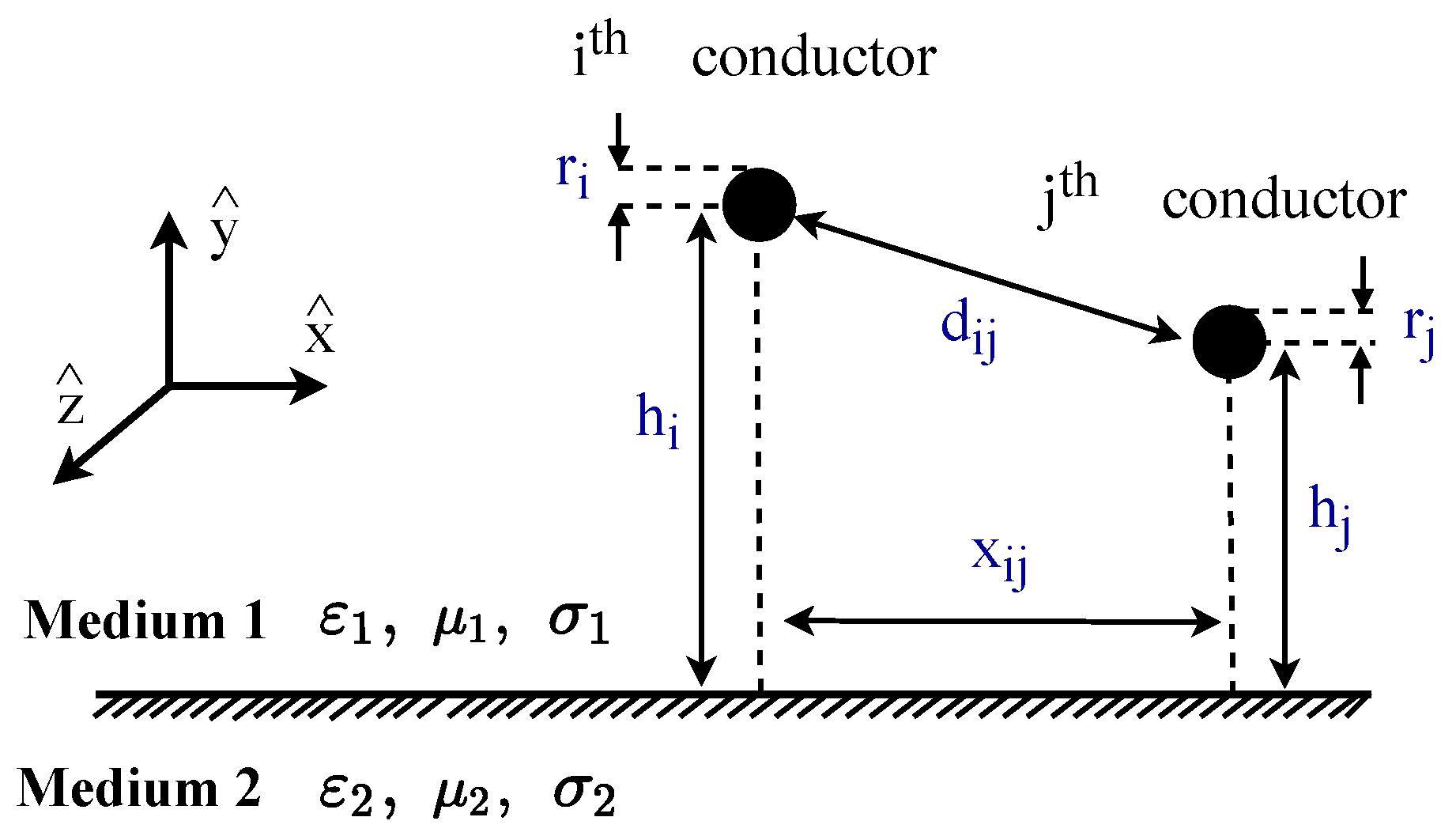
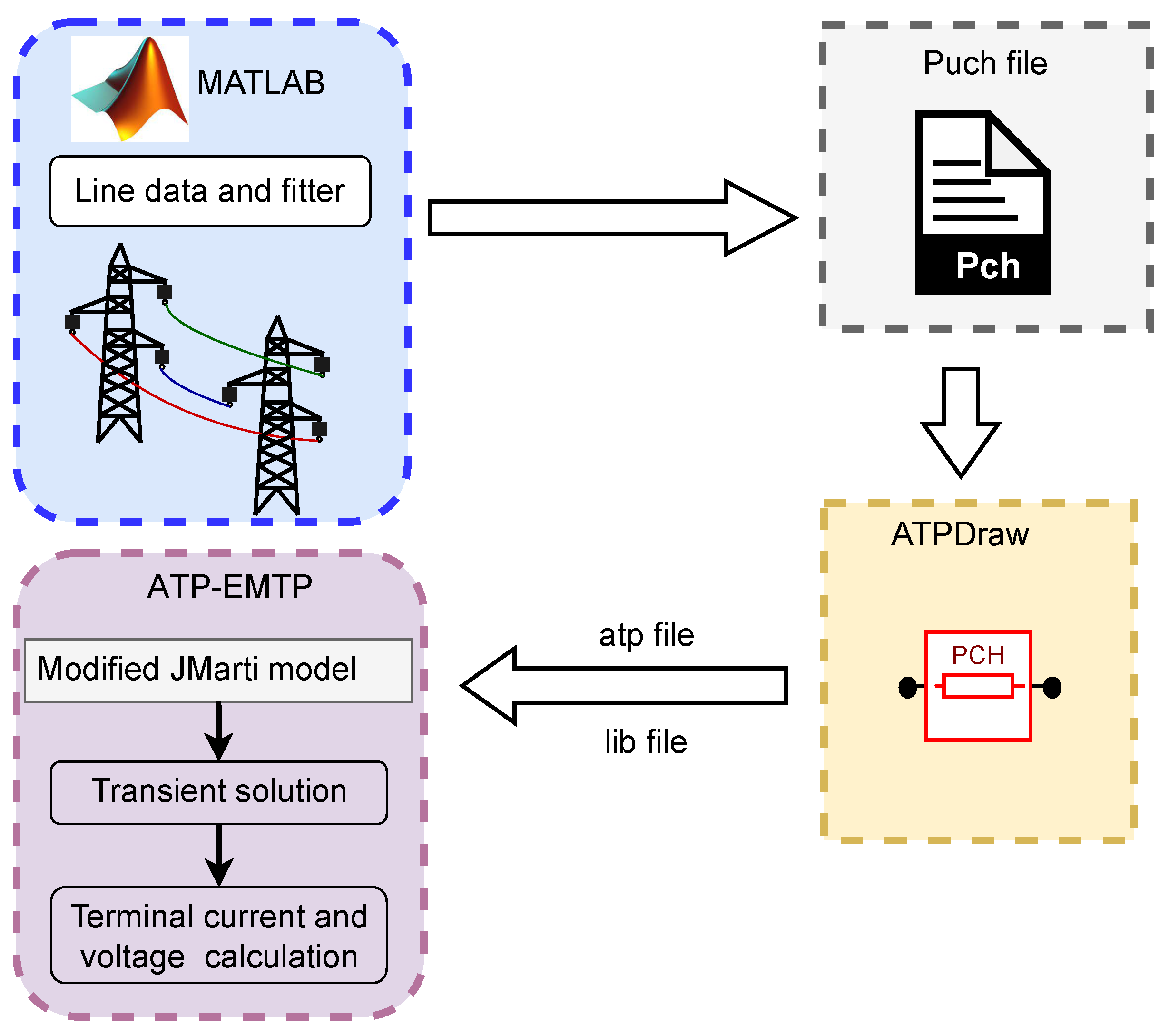

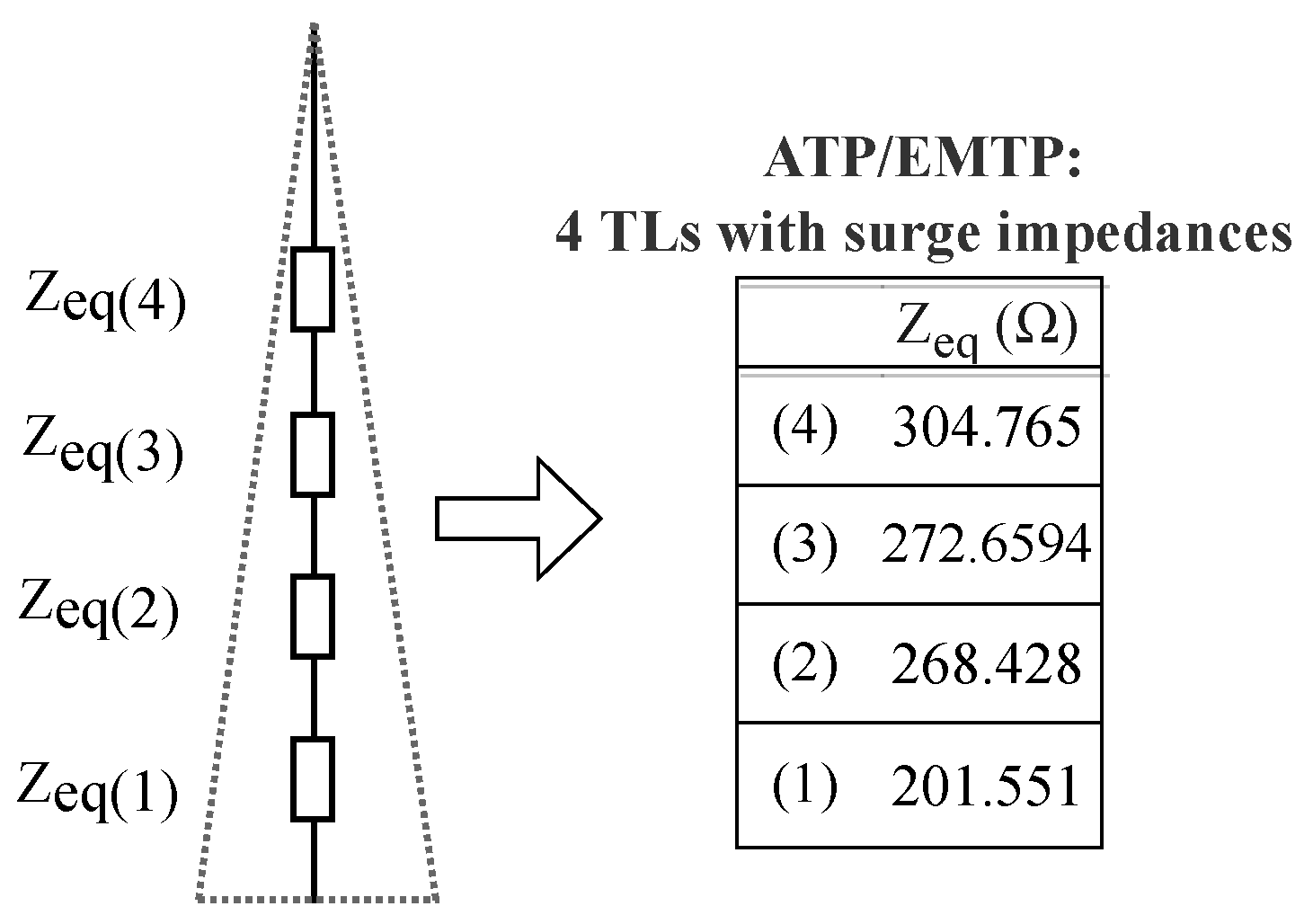
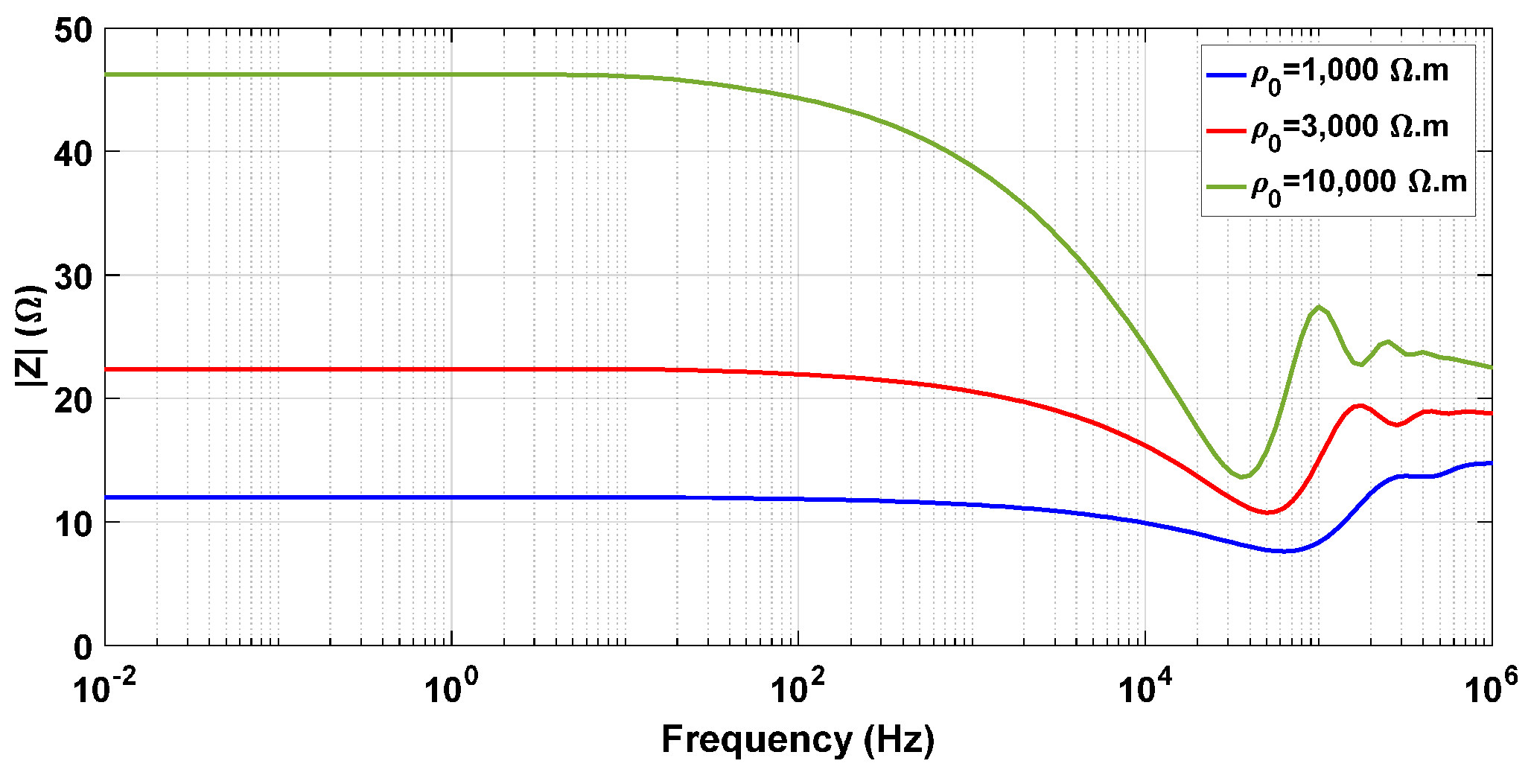
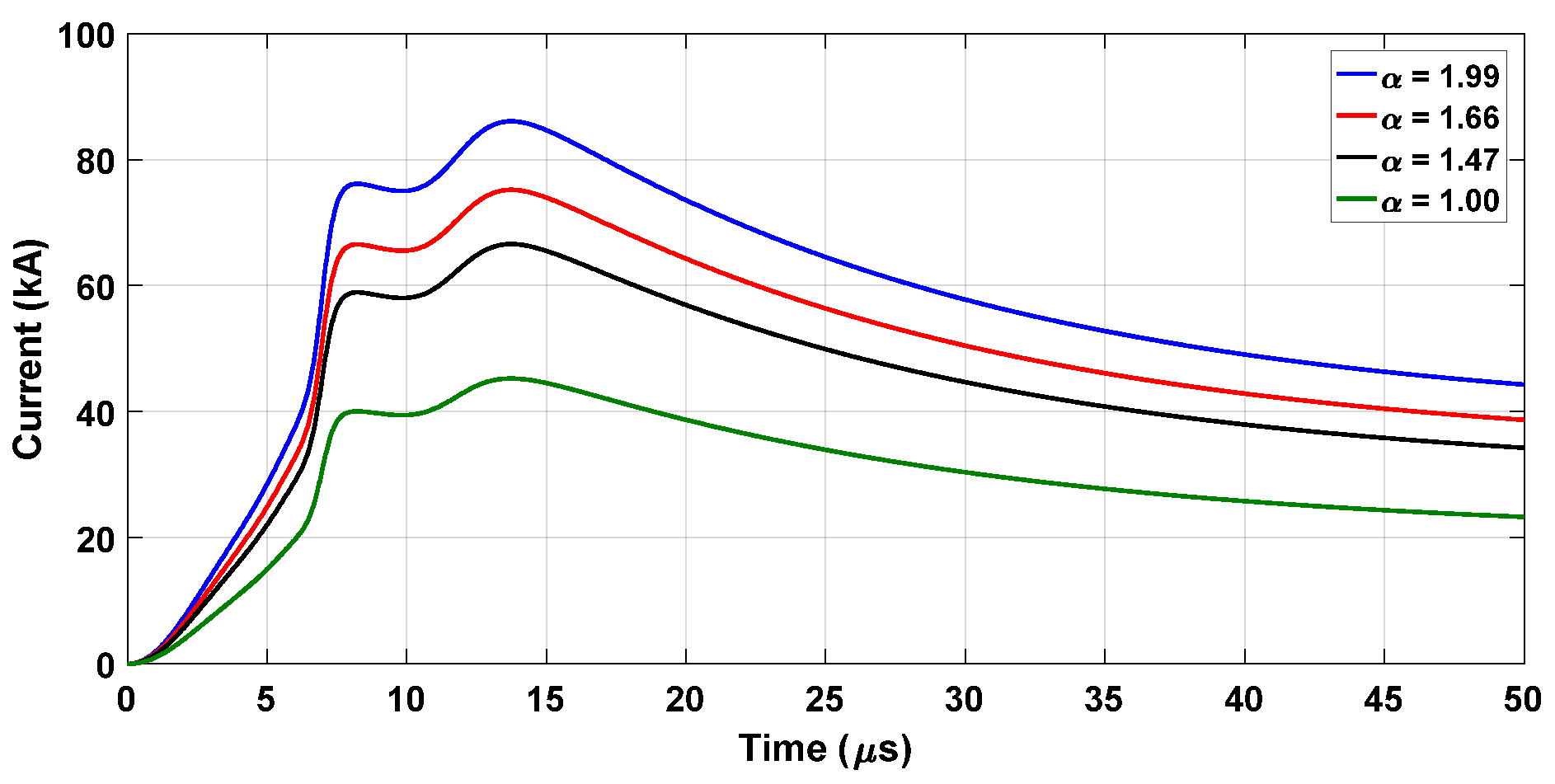


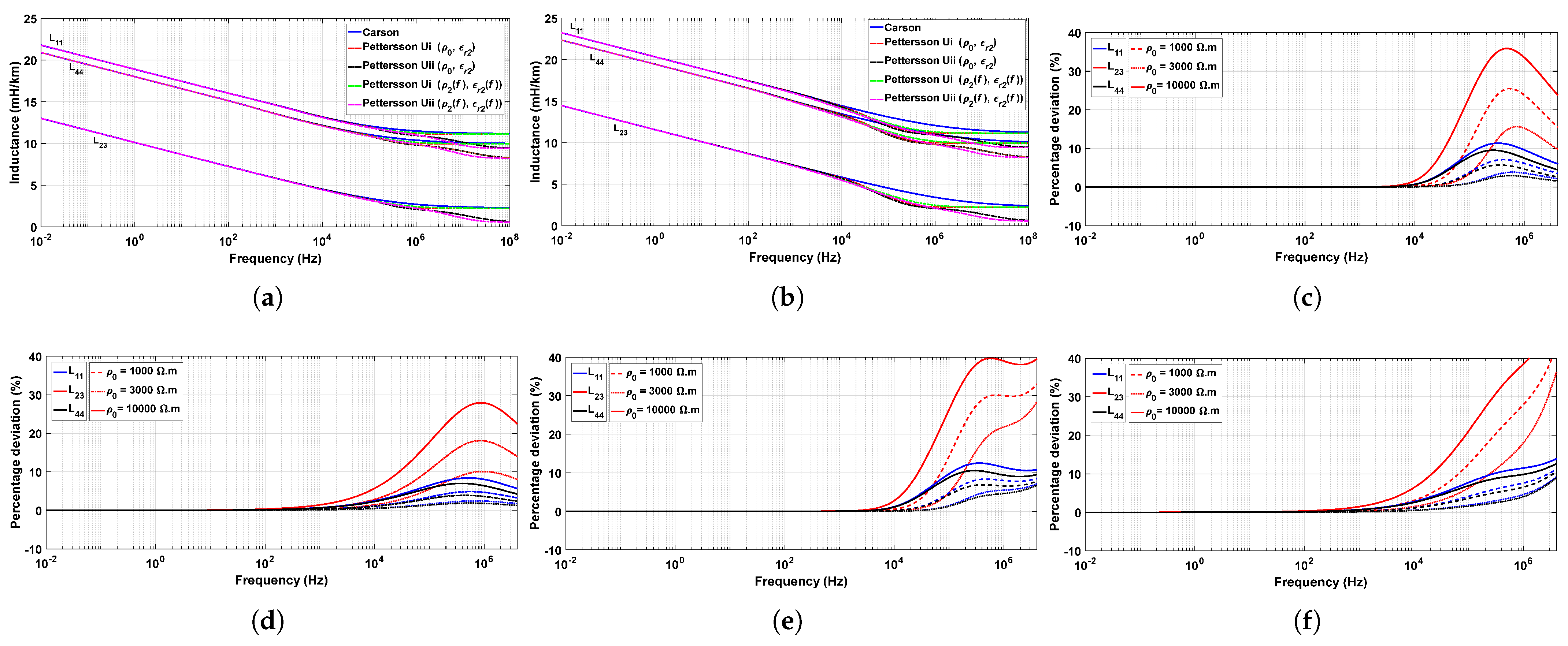
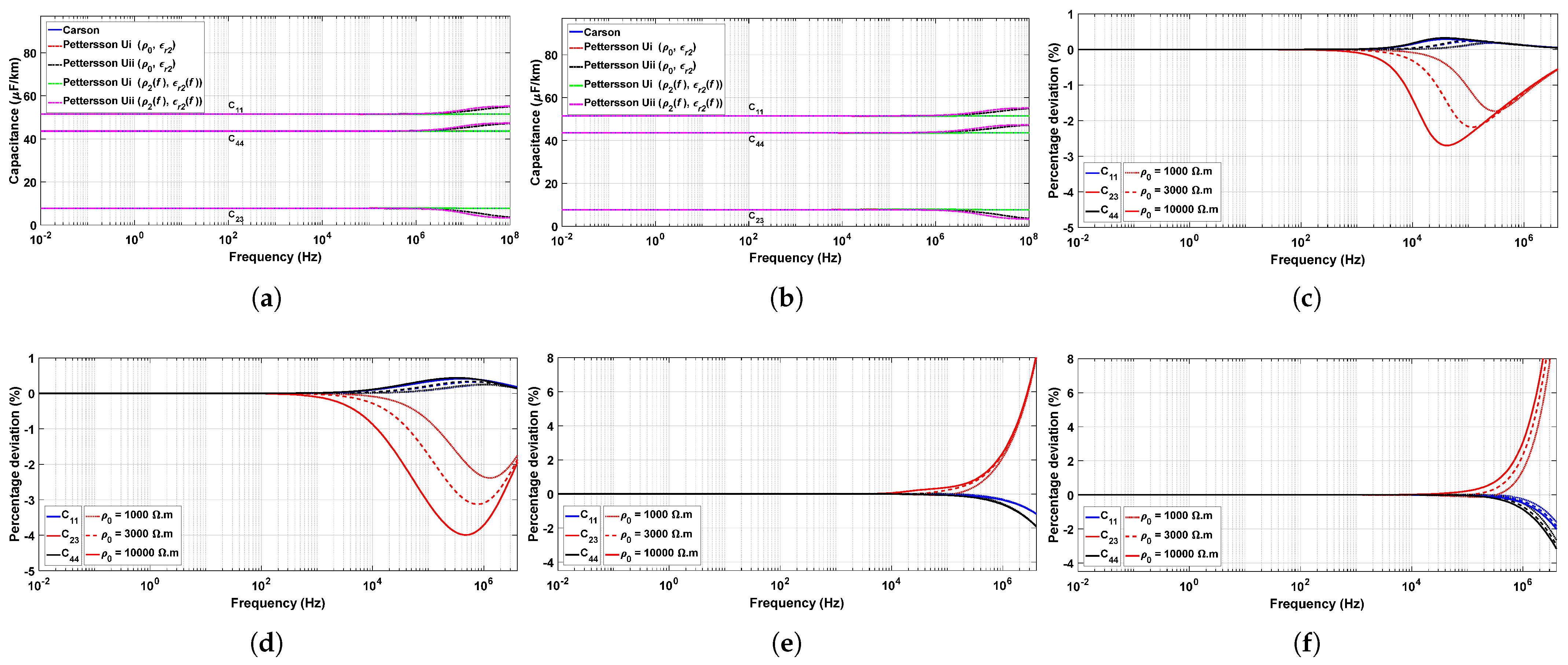

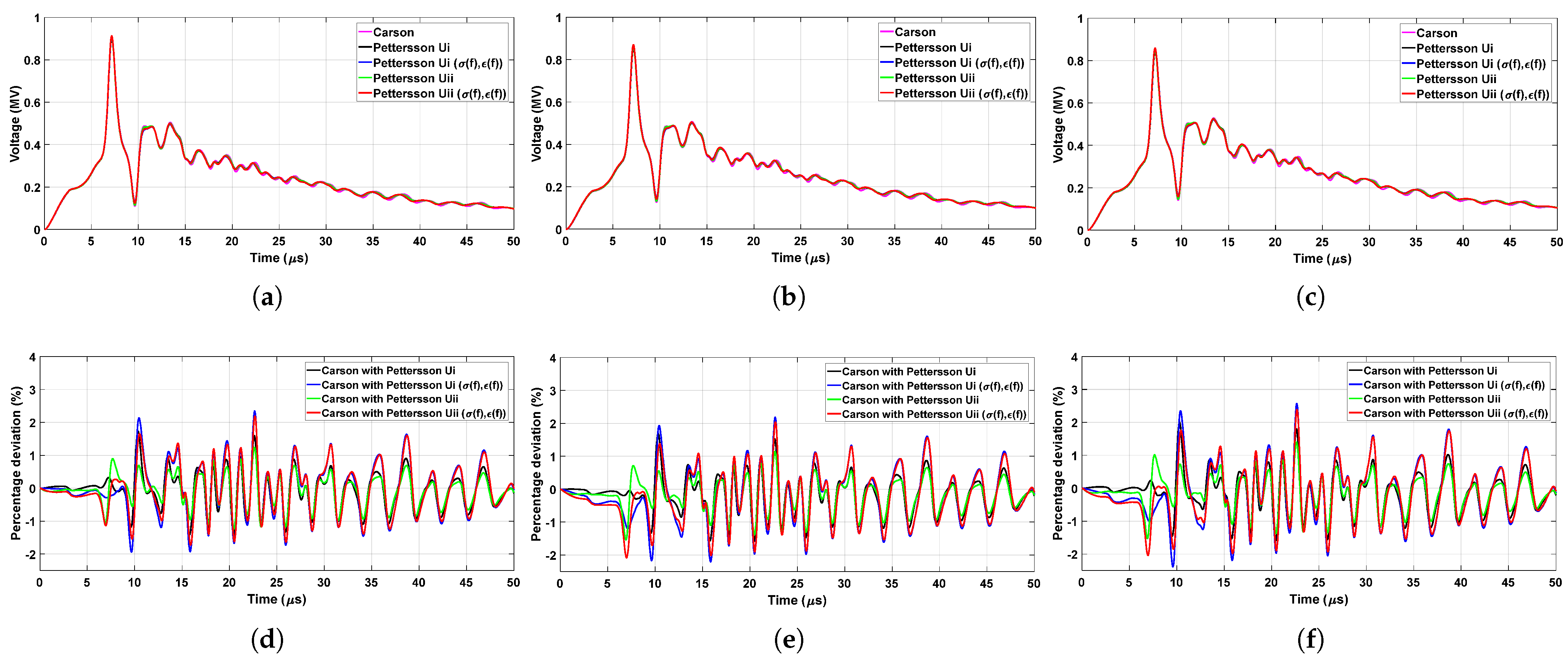
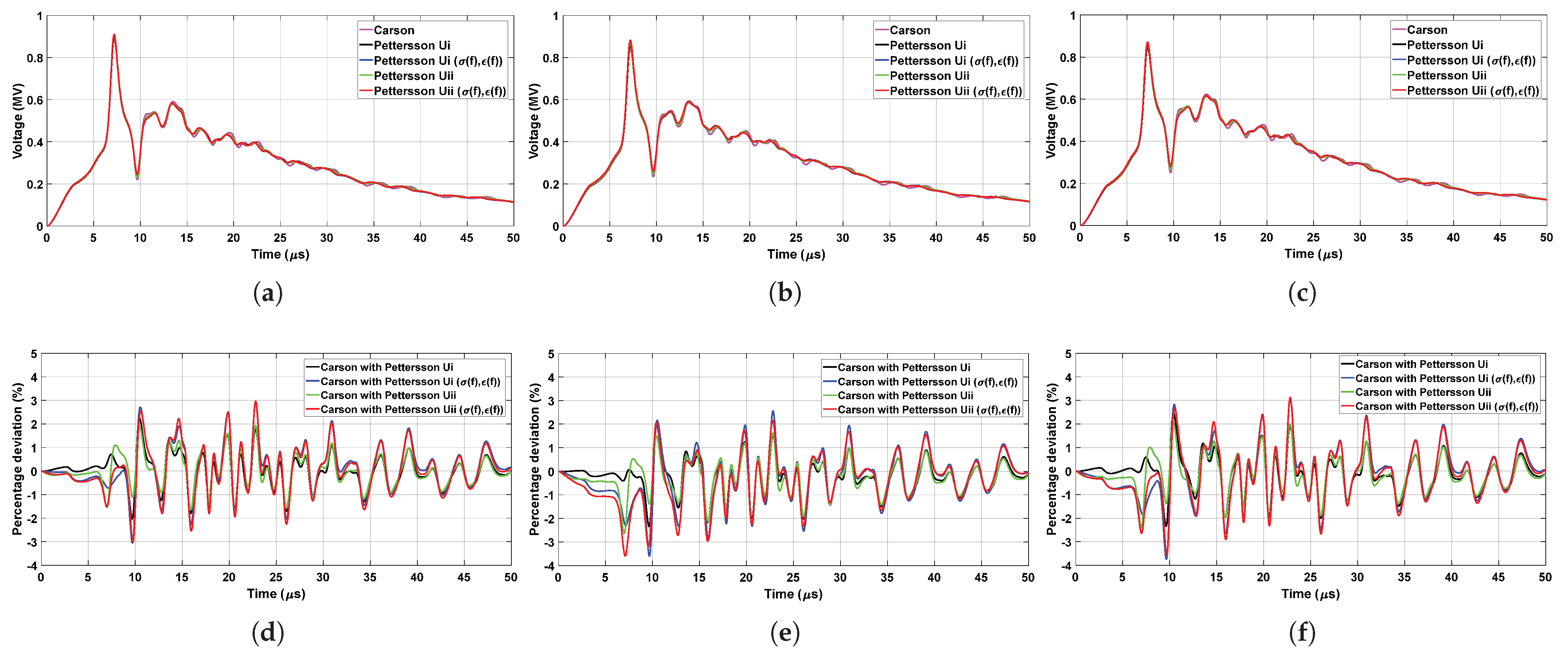
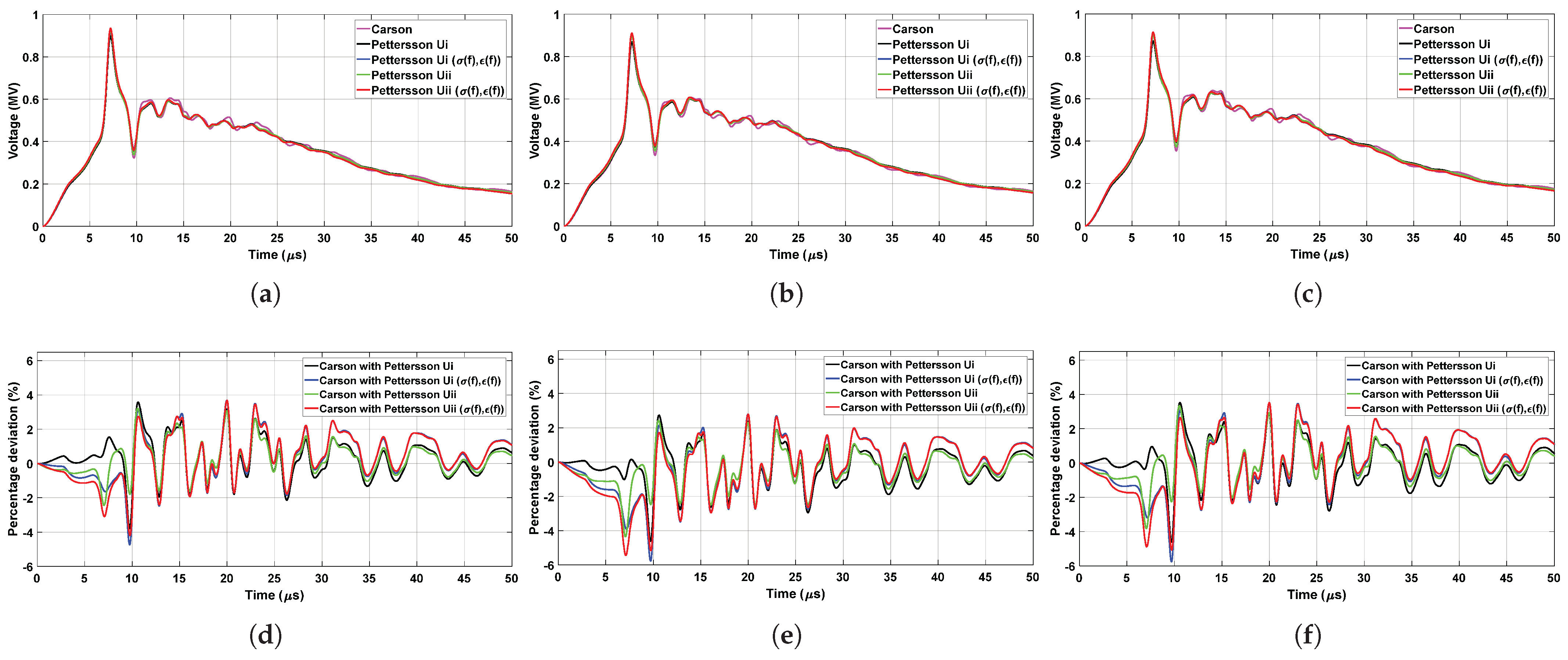



| Phase | Outer Radius (cm) | DC Resistance (Ω/km) | |
|---|---|---|---|
| Phase cables (ACSR) | A B C | 1.60 1.60 1.60 | 0.063 0.063 0.063 |
| Ground wire (3/8” EHS) | GW | 0.79 | 0.500 |
| (Ω.m) | 1000 | 3000 | 10,000 |
|---|---|---|---|
| (m) | 55 | 100 | 180 |
| Representation | TL Model | Formulation | Soil for TL |
|---|---|---|---|
| 1 | JMarti | Carson | |
| 2 | Modified JMarti | Pettersson | , |
| 3 | Modified JMarti | Pettersson | (f), (f) |
| 4 | Modified JMarti | Pettersson | , |
| 5 | Modified JMarti | Pettersson | (f), (f) |
| (MV) | (%) | |||||
|---|---|---|---|---|---|---|
| = 1000 .m | ||||||
| Rep. | A | B | C | A | B | C |
| 1 | 0.905 | 0.855 | 0.845 | - | - | - |
| 2 | 0.907 | 0.855 | 0.843 | 0.232 | 0.070 | 0.225 |
| 3 | 0.908 | 0.865 | 0.853 | 0.276 | 1.194 | 0.982 |
| 4 | 0.910 | 0.866 | 0.855 | 0.497 | 1.385 | 1.195 |
| 5 | 0.913 | 0.870 | 0.859 | 0.839 | 1.778 | 1.609 |
| = 3000 .m | ||||||
| A | B | C | A | B | C | |
| 1 | 0.899 | 0.853 | 0.853 | - | - | - |
| 2 | 0.894 | 0.854 | 0.849 | 0.556 | 0.152 | 0.399 |
| 3 | 0.905 | 0.872 | 0.868 | 0.712 | 2.286 | 1.818 |
| 4 | 0.908 | 0.876 | 0.870 | 1.023 | 2.368 | 2.052 |
| 5 | 0.913 | 0.882 | 0.874 | 1.635 | 3.424 | 2.171 |
| = 10,000 .m | ||||||
| A | B | C | A | B | C | |
| 1 | 0.908 | 0.870 | 0.874 | - | - | - |
| 2 | 0.898 | 0.870 | 0.871 | 1.092 | 0.589 | 0.332 |
| 3 | 0.923 | 0.899 | 0.902 | 1.641 | 3.896 | 3.134 |
| 4 | 0.927 | 0.899 | 0.902 | 2.104 | 3.965 | 3.215 |
| 5 | 0.935 | 0.911 | 0.914 | 2.941 | 5.248 | 4.541 |
| (Ω.m) | Backflashover Occurrence | ||
|---|---|---|---|
| Insulator String in Phase | Types of Modeling Representations (Table 3) | Disruption Time (s) | |
| A | 1, 2, 3, 4 and 5 | 7 | |
| 1000 | B | - | - |
| C | 1, 2, 3, 4 and 5 | 15 | |
| A | 1, 2, 3, 4 and 5 | 7 | |
| 3000 | B | 1, 2, 3 and 4 | 15 |
| C | 1, 2, 3, 4 and 5 | 15 | |
| A | 1, 2, 3, 4 and 5 | 7 | |
| 10,000 | B | 5 | 7 |
| 1, 2, 3 and 4 | 15 | ||
| C | 1, 2, 3, 4 and 5 | 15 | |
Disclaimer/Publisher’s Note: The statements, opinions and data contained in all publications are solely those of the individual author(s) and contributor(s) and not of MDPI and/or the editor(s). MDPI and/or the editor(s) disclaim responsibility for any injury to people or property resulting from any ideas, methods, instructions or products referred to in the content. |
© 2023 by the authors. Licensee MDPI, Basel, Switzerland. This article is an open access article distributed under the terms and conditions of the Creative Commons Attribution (CC BY) license (https://creativecommons.org/licenses/by/4.0/).
Share and Cite
Leon Colqui, J.S.; Ribeiro de Moura, R.A.; De Oliveira Schroeder, M.A.; Filho, J.P.; Kurokawa, S. The Impact of Transmission Line Modeling on Lightning Overvoltage. Energies 2023, 16, 1343. https://doi.org/10.3390/en16031343
Leon Colqui JS, Ribeiro de Moura RA, De Oliveira Schroeder MA, Filho JP, Kurokawa S. The Impact of Transmission Line Modeling on Lightning Overvoltage. Energies. 2023; 16(3):1343. https://doi.org/10.3390/en16031343
Chicago/Turabian StyleLeon Colqui, Jaimis Sajid, Rodolfo Antônio Ribeiro de Moura, Marco Aurélio De Oliveira Schroeder, José Pissolato Filho, and Sérgio Kurokawa. 2023. "The Impact of Transmission Line Modeling on Lightning Overvoltage" Energies 16, no. 3: 1343. https://doi.org/10.3390/en16031343
APA StyleLeon Colqui, J. S., Ribeiro de Moura, R. A., De Oliveira Schroeder, M. A., Filho, J. P., & Kurokawa, S. (2023). The Impact of Transmission Line Modeling on Lightning Overvoltage. Energies, 16(3), 1343. https://doi.org/10.3390/en16031343










